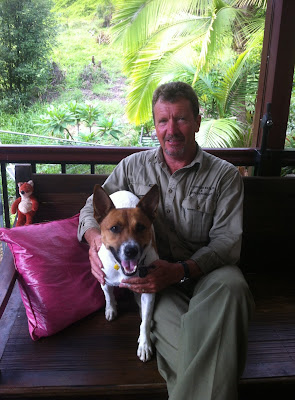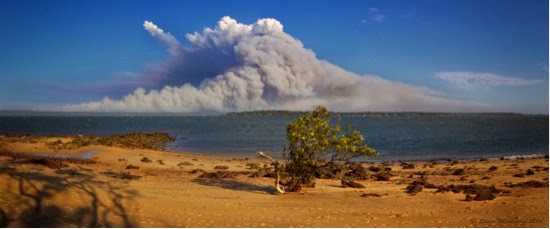Fox Free Stradbroke Island?
A concerted effort to stop the ongoing spread of foxes on North Stradbroke Island must be a priority, if native species are to be protected.
 |
| Michael Dickinson with Koda his new fox detection dog who will work on NSI when her training is completed. |
One of the most loved elements of North Stradbroke Island, aside from the spectacular beaches, is the pristine environment and the native animals that inhabit it.
Unbeknownst to many, these animals are at threat, as the number of predatory red foxes continues to grow on the Island.
Michael Dickinson, a former National Parks ranger, and now a wildlife spotter and catcher, has been undertaking fox and feral animal control for the Redland City Council on its island land for the past four years. In that time Michael has trapped 118 foxes. “It’s thought that foxes started appearing on NSI in the mid-1930s and their numbers have steadily grown. Just from my work here, I estimate there’d be over 1000 foxes now living on the Island.” said Dickinson.
Many Island residents regularly spot foxes, and they are picked up on wildlife monitoring cameras and recorded on all the pre-mining environmental studies by scientists.
Fox predation is not a new story to Queensland, or Australia. It is an animal with a wide and varied diet, invasive nature, good breeding rate and few natural enemies. The fox’s threat to the survival of native Australian fauna has seen long term control and eradication programs successfully implemented on Phillip Island in Victoria (to protect the Fairy Penguins), and recently commenced in Bundaberg (to protect the breeding turtles), and throughout Tasmania.
With insufficient controls in place on NSI, the increasing number of foxes will bring disastrous ecological consequences to the island. Evidence from across Australia shows that fox predation is a major threat to the survival of native Australian fauna. Terrestrial animals at the greatest risk are those that weigh between 35 and 5500 grams - on NSI these animals include the young of the island’s Agile Wallabies and Northern Brown Bandicoot which are rarely seen now, the rare and endangered Water Mouse, Common Planigale (marsupial mouse), lizards, Sugar Gliders and frogs. These animals are at particular threat as their numbers are unable to be boosted due to the Island’s natural quarantine border of water. Ground-nesting and feeding birds such as the Island’s Beach Stone Curlew, Rainbow Bee Eaters, plovers, ducks and shorebirds are also prey.
Given the extent of their impact on biodiversity, predation by the European red fox has ensured its listing by the World Conservation Union as one of the 100 worst invasive species in the world. The Australian Government lists fox predation as a key threatening process under the Commonwealth’s Environment Protection and Biodiversity Conservation Act 1999 (EPBC Act).
Many of us who have kept chickens will know of the devastating ‘thrill kill’ or ‘multiple killing’ behaviour of the fox where it kills more animals than it needs for food. Unfortunately foxes on NSI exhibit this behaviour as Dickinson reports when foxes regularly attack the beach nests of the endangered Loggerhead Turtles. "The foxes monitor the nests and, with their excellent hearing and sense of smell, dig up and attack the nests killing all the newly hatched turtles," Dickinson said. Older island residents still recall the terrible events of 1991 when a fox killed 300 Wedge-tailed Shearwaters in a single night on Camel Rock, destroying a small nesting colony which has never been able to re-establish.
Eradicating these feral animals involves a range of strategies. One of newest is the use of specially trained sniffer dogs to find fox dens. Dickinson himself has recently recruited a fox detector dog ‘Koda” to his team who will be working on the island when her training is completed. As feral cats are also a problem on the island (Michael alone has caught nine of the notoriously difficult to catch feral cats) and their numbers could increase if foxes are removed, it’s crucial that an effective feral predator management strategy target both foxes and feral cats.
Because NSI is an island it is possible - with the long term commitment and support of all the island land managers - to eradicate foxes.
The Phillip Island program, after several decades of general fox control work, finally took 5 years using an island-wide, properly resourced, concentrated program to achieve a 90% reduction in fox numbers and hopes to be declared fox-free soon.
NSI is bigger and with a greater fox load but we could have the same success using a long term strategy over 10 to 20 years involving all stakeholders – Redland City Council, Quandamooka Native Title Holders, National Parks managers, SEQ Water, SEQ Catchments and Sibelco - along with community groups, residents and visitors to the island.
For the sake of the island’s wildlife let’s aim to make Straddie fox-free once again.
Article, as previously published in the Autumn edition of Straddie Island News, by Mary Barram. References listed below and photos courtesy of Michael Dickinson.


